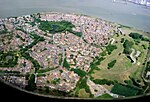Crossness Pumping Station

The Crossness Pumping Station is a former sewage pumping station designed by the Metropolitan Board of Works's chief engineer Sir Joseph Bazalgette and architect Charles Henry Driver. It is located at Crossness Sewage Treatment Works, at the eastern end of the Southern Outfall Sewer and the Ridgeway path in the London Borough of Bexley. Constructed between 1859 and 1865 by William Webster, as part of Bazalgette's redevelopment of the London sewerage system, it features spectacular ornamental cast ironwork, that Nikolaus Pevsner described as "a masterpiece of engineering – a Victorian cathedral of ironwork". It is adjacent to Erith Marshes, a grazing marsh, the northern part of which is designated as Crossness Nature Reserve. This provides a valuable habitat for creatures ranging from moths to small amphibians and water voles.
Excerpt from the Wikipedia article Crossness Pumping Station (License: CC BY-SA 3.0, Authors, Images).Crossness Pumping Station
Bazalgette Way, London
Geographical coordinates (GPS) Address Nearby Places Show on map
Geographical coordinates (GPS)
| Latitude | Longitude |
|---|---|
| N 51.509142 ° | E 0.138418 ° |
Address
Crossness Sewage Treatment Works
Bazalgette Way
SE2 9AR London (London Borough of Bexley)
England, United Kingdom
Open on Google Maps








